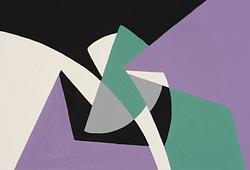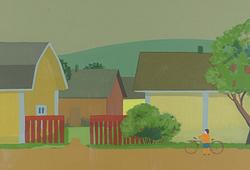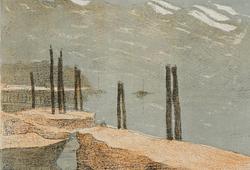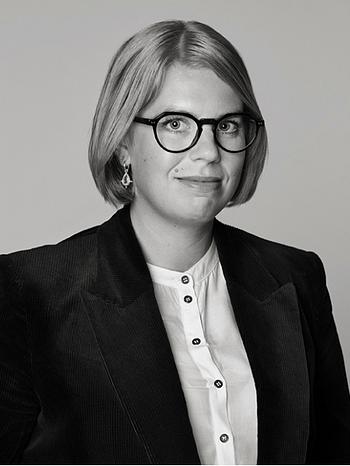Åke Göransson
"Organisten"
Stamp signed Åke G and signed and certified verso. Executed in 1933/37. Canvas 30.5 x 23 cm.
Provenance
Hjalmar Gabrielson, Gothenburg.
Erik Sahle, Gothenburg.
Collection Håkan Larsson, Tranemo.
Exhibitions
Modern Konst i Hemmiljö, Stockholm, 1941, cat. no. 141.
The Art Hall, Gothenburg, 1942, cat. no. 154.
Stenmans Daughter, Stockholm, 1944, cat. no. 67.
Gothenburg Museum of Art, 1949, cat. no. 96.
Gothenburg Museum of Art, Varberg Museum, Norrköping Art Museum, 1977, cat. no. 72.
Liljevalchs konsthall, Stockholm, 1977-78, cat. no. 78. National Exhibitions, 1978-79, cat. no. 18.
Gothenburg Museum of Art, 1998-99 without cat. no.
Literature
Björn Axlund, "Colour Form - Åke Göransson's Life and Art", 2002, listed as cat. no. 193.
More information
The auction's painting depicts a room in shades of blue and black, where a man sits on a three-legged chair playing an instrument with a brick-red top. He is dressed in rust red with hints of green, and his face has a distinct green tone. In the lower right corner, part of a reddish-brown tabletop is visible. At the top of the painting is a window through which a landscape can be glimpsed – dark blue, blue-white and green with rust-coloured patches – all in twilight.
On the back of the painting is a still life. Against a yellow-grey background lies a brown pipe with a blue stem next to a yellow-brown carafe casting its shadow to the right. This painting is signed in the upper right corner, somewhat indistinctly: Åke Göran.
Artist
Åke Göransson was born in Veddige in Halland 1902. His parents were shoemaker Sven GÖransson and his wife Hanna. Sven Göransson died when Åke was only three years od and thus his mother Hanna came to play a big role in Åke's life, both as a breadwinner and a support system. Åke eventually starts working as a barbor, drawing and painting on the side for Hermods. He eventually got engaged to Inga Andersson. In 1924, Åke becomes a part time student at Valand's art school, but his tricky economic situation forces him to work halftime as a barbor. He became somewhat of a hermit, but at school he spent time with other artists who railed around their teacher Tor Bjurström. After a short period of stability begins the tendancies of poor mental health show itself. From 1932 his health deteriorates, he is deemed mentally insane, and he finds himself to leave his mothers apartment in Landala. It is from this period that the most interesting and intensive paintings were made. Torn from the world, Göransson continuously paints new versions of his view of Egnahemsvägenin Landala, interiors from the studio flat, with Hannah often lurking in the photographs. His friends from his studies find themselves intranced by his canvas paintings, and his friend Ivan Ivarson convinces Göransson to lend three artworks to the collection exhibition of 1933 at Paletten in Gothenburg. The exhibition is greatly received and brings national fame to Göransson's art. However, he is simultaneously experiencing an internal crisis and depression, and it becomes impossible for im to continue painting, and thus cannot continue to support his wife and daughter Ingrid. After this his artworks fluctuates with his state of mind, the dark is contrasted with the light, light with darkness. In the long run, his mother can no longer continue to support him with all of the art supplies he needs, and he instead begins to paint over old canvases. In 1937 Göransson was finally emitted into Gothenburgs new mental hospital. He was in terrible form, both mentally and physically, since he suffered from tuberkulosis, weighed only 48 kilos, and had full fledged schizophrenia. He remained at the hospital until his death in 1942.
Åke Göransson's artistic career would likely have faded into obscurity if Arne Stubelius had not made a spontaneous visit to Göransson's mother, Hanna, one summer day in 1940.Stublius worked with monographs like Ivan Ivarson and wanted to verify some facts. One time, Stublius asked if there were any more of Göransson's art left in the home. Göransson's mother asked her son to mobe off the sofa, where upon opening the sofa cover, they found the home of Göransson's art. This marked the beginning of Åke Göransson’s artistic career being brought into the spotlight. Through purchases, Gösta Stenman enabled the rescue of the works. They were restored, mounted on panels, and framed. The exhibition at Modern Konst i Hemmiljö on Strandvägen in Stockholm in 1941 was received very positively and marked the start of significant attention towards Göransson’s work. Only a few paintings were created in the hospital the following year before Åke Göransson passed away from mental exhaustion and tuberculosis in 1942.
Read more


















































